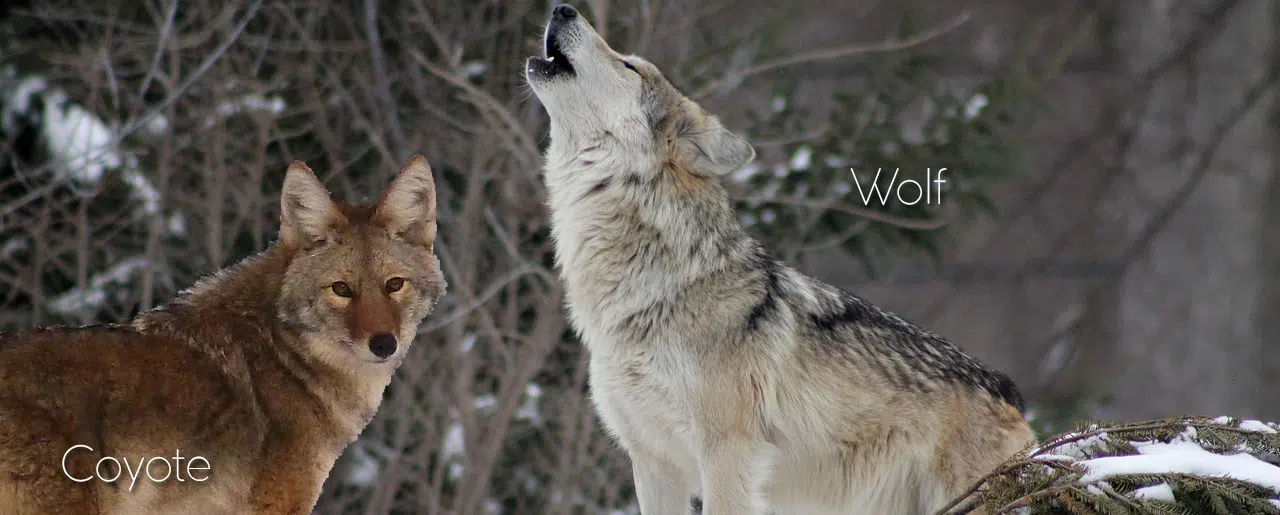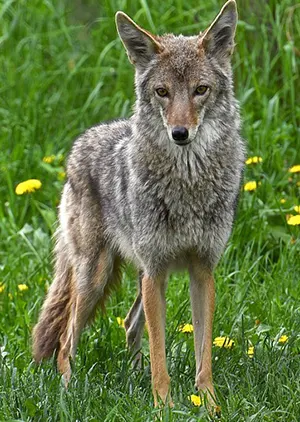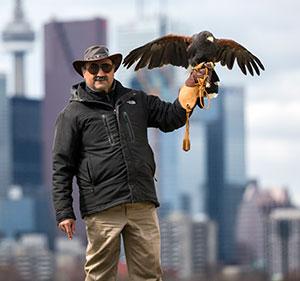Both, coyote and wolf have special importance in many cultures and hold spiritual symbolism. Both are thought to represent strength, wisdom, and may evoke feelings of foreboding peril. Both are revered and feared at the same time, due to their intelligence, speed, power, and prowess. But, how do you tell them apart?

Understanding Coyotes and Wolves
Telling apart a coyote and a wolf isn't terribly difficult if they appear side-by-side. Of course, that's not usually the case. You'll likely only see one or the other. So, let's look at a few coyote and wolf behaviors, some markers and characteristics that may enable us to determine if the canine we are seeing is a coyote or a wolf.
Geographical Distribution
Coyotes (their name is derived from the Aztec 'coyotl') are native to North and Central America but most prominent throughout Canada and the United States. Wolves can be found throughout North America, Europe, and even in Asia. Wolves are highly adaptable and inhabit a wide range of terrains including temperate forests, mountains, tundra, taiga, grasslands, and deserts. Coyote and wolf habitats are not unlike; both species can be seen in similar habitats in Canada.
In recent years, coyotes have moved in to suburbs and even urban neighbourhoods (and caused some havoc, too). Wolves really are much less inclined to hang around people; they may linger around farms and livestock, though.
Coyote or Wolf? 7 Easy Ways to Tell These Canines Apart
1. Size and Body Shape Differences
 There's a huge difference in size and weight between coyotes and wolves. As with most canines, the male is generally larger and heavier than the female.
There's a huge difference in size and weight between coyotes and wolves. As with most canines, the male is generally larger and heavier than the female.
Coyote
The average coyote will weigh 25-40lbs, although animals weighing as much as 55lbs have been recorded. Overall, coyotes have a fairly slim frame.
Wolf
The wolf is the largest member of the dog, or Canid, family, with a body weight of 40-145lbs (so more than double the size of a coyote) and a more stocky or bulky silhouette. What we see here in Ontario is most likely the Gray Wolf, or occasionally a Timber Wolf.
2. Facial Features and Expressions
Not unlike our trusted companion, man's best friend, both coyotes and wolves not only communicate through facial expressions and body language, but also show their personality in face and body. While there are a few expressions understood by all, there are many nuances that are pack or even animal specific. Experessions common across all canine species are anger or aggression (raised lips, showing teeth, crinkled nose, ears pinned). Also, the lower the rank in the pack, the more elaborate their facial expressions; higher ranking or more dominant animals seem get their point across by status alone.
Coyote
Coyotes have a narrow face with a long and fairly slim snout. Their ears are wide set, large and pointy. The eyes are yellow and they are capable of making 'puppy dog eyes' - you know, that 'pleeeeease' look that happens when the inner corners of the eyebrows are raised.
Wolf
Wolves have a broader face, a wider snout and shorter, more rounded ears. Joy is expressed by ears pointing forward and pulling the corners of the lips back and a dropping of the jaw, resulting in a 'smile' that is characteristic for Northern dog breeds as well (think huskie, malamute, chow, spitz, etc.)
3. Coat Color and Texture
 Coyote
Coyote
Coyote coats are perfectly constructed to insulate against the elements, reaching 4-5 inches in length during the winter and appearing big and puffy - thus making the animal look much larger than it is. This winter coat will shed in the spring time and a new coat will grow in towards the end of summer. Oils and a generous undercoat allow the animal to stay relatively dry in a downpour. As far as colour goes - well, just about anything goes! Coyotes can appear in a host of shades from light tan or reddish to nearly black - and anything in between. Either way, they generally blend in beautifully with their surroundings.
Wolf
A wolf's coat is also made up of two different types of fur; a soft and dense layer of undercoat and coarse outer coat with longer guard hairs. The longest fur is located behind the shoulders, often called a “cape.” Most wolves fall into the white-silver-grey-black colour scheme, although red tones are also possible. Colour research suggests that the gene responsible for producing black wolves also signals resistance to Canine Distemper and moreover, that animals may choose mates based on health assessments derived from coat colour.
4. Tail Characteristics
Coyote
A coyote's tail has been likened to looking like a paint brush; it can be full and bushy or slim - but almost always with a black tip. Coyote's carry their tail low, facing down or straight out and away from their body. Unlike domestic dogs, a coyote's tucked tail does not signal fear, but rather is a display of dominance. It is usally accompanied by raised hackles and an arched back.
Wolf
The wolf's tail is shorter than that of a coyote, bushy and more uniform. Think 'bottle brush' rather than paint brush. The tail is an important tool of communication and fairly close to what we expect to see from our dogs. A wagging tail can signal joy or excitement, a tucked tail will convey fear or submission to a more dominant animal in the pack.
5. Paw Size and Shape
Coyote
Coyote paw prints are ovular and can measure 2.5 to 3.5 inches in length. Often, you'll observe sharp claw marks on the front two toes. The print will show four toes close together, as opposed to the wider, more splayed spread of dog toes.
Wolf
A wolf paw is large (close to the size of a human hand) with long, well arched toes. The middle toe is longer than the rest and there's webbing extending about halfway between the toes. This webbing contains scent glands, communicating to wolves from other packs and marking territory.
6. Pack vs. Solitary Habits
Coyote
While coyotes live in families or packs, they tend to hunt on their own. It's usually an alpha couple living with 3-4 lower ranking family members.
Wolf
Wolves have an intricate hierarchy and highly evolved social structure within the pack. Everyone has a place and a job. A pack may be made up of up 12 or more members. Unlike coyotes, wolves hunt as a pack as well, even deploying team work in stalking and taking down prey.
7. Hunting Techniques
Coyote
While coyotes mainly hunt in solitude, they will adjust to hunting and sharing as a group for larger prey. They are opportunistic hunters and will huntin cooperation with other species, such as badgers, or follow the sounds of crows to find food. Since they also consume carrion, they are not above the spoils of other hunters.
Wolf
Wolves are intelligent and cooperative hunters. In their approach, they will switch between ambush and cursorial hunting, depending on the prey. Often, the pack will fan out and surround prey, operating as a cohesive unit.
What to Do If You Encounter a Coyote or Wolf
DO NOT ENGAGE. While it is unlikely that you will encounter a wolf that will stick around in your presence, you may very well happen upon a coyote or even find yourself being stalked by one. Especially since much reduced human traffic during the COVID era, coyotes have moved into the suburbs and even urban areas and may show little fear of people. There are some techniques when retreating from a coyote - have a look.
Beyond that - please do not try to take on a coyote or wolf on your own. Contact Hawkeye Bird & Anima Control. We are not only licensed but also experienced when it comed to dealing with coyotes or wolves and wildlife management.














